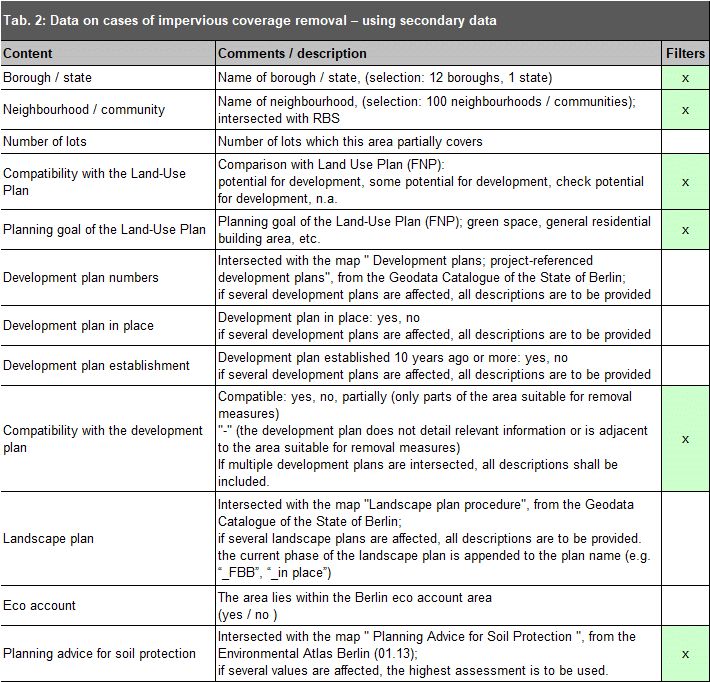Moreover, there are four criteria which are meant to guide the prioritisation of potential areas for the removal of impervious coverage:
- property rights,
- expert assessment,
- technical effort, and
- time required for implementation.
For each case, this prioritisation is carried out using a three-point scale. If a case cannot be evaluated, “n. a.” is entered. Additional comments may be entered in the comment box linked to the evaluation as needed (cf. Tab. 3).
In the evaluation of property rights/ area availability, areas, which are the property of the State of Berlin, or which can generally be considered available for other reasons (e.g. if an agreement with the private owner has already been reached) are classified as “high”. Areas which are predominantly the property of the Berlin Properties Fund (LSF), or, to the extent that is known, can be attributed to the Institute for Federal Real Estate (BIMA), or some other federal agency (e.g. the Federal Waterways) fall into the “medium” category. Areas with an unkown property situation, i.e. generally areas either in private ownership or federal assets, are classified as “low”.
Areas are classified as “high” in the expert assessment, if their impervious covers may be removed completely, and if the resulting open space connects to other green and open spaces that are already in place or being planned. Areas receive a “medium” rating if they do not contain large, contiguous areas suitable for removal measures. They are rather characterised by large areas suitable for partial removal measures or scattered areas suitable for a complete removal. Finally, areas suitable for small-scale isolated measures, or a very limited partial removal only, are classified as “low”. The expert assessment also considers information on the hydraulic removal of impervious coverage. It refers to previously (fully) impervious areas that have received a new type of cover that is permeable to water and air, as these areas often still play a role in development (paths, courtyards, parking spaces, etc.). The idea here is
to improve the infiltration of precipitation. The size of the area suitable for removal measures cannot usually be precisely quantified in square metres. It must be determined on site on a case by case basis. The possibility of changing the type of cover for partial areas may also be explored here.
The ascertainment of the technical effort depends on the type of impervious cover, or the degree of development of the area. A large need for building demolition or a large proportion of multistorey buildings, which may have basements, thus implies a high level of effort. A simple removal of impervious covers, such as that of pathway or roadways, constitutes a low level of effort. Between the two are demolition measures of a medium level of effort, involving the removal not only of the cover itself, but also of small structures, such as cottages, garages or other special structural facilities, such as greenhouses.
In order to assess the implementation timeframe, a rough estimate of the necessary planning effort/ preliminary work was carried out. The implementation timeframe was then categorised as short-term (1 to 2 years), medium-term (up to approx. 5 years), or long-term (more than 5 years).




